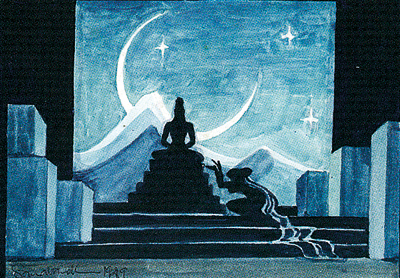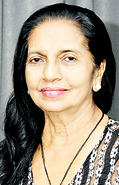Oriental designs and sets from the past
How does one imagine what the Buddha really looked like? What were Mara’s three daughters wearing, when they came to entice the Buddha? How did King Sri Sanghabodhi appear to his people in Anuradhapura in the 3rd century ? We would often have to refer the archive in the Buddhist image house, puppets packed up in the puppeteers boxes and the discoloured costumes behind the dusty glass panes in our National Museums.

Paintings, drawing and sketches for theatre costumes and sets by Somabandu Vidyapathy exhibited at the Goethe Institute Colombo shows to what extent, our modern costume designers for stage, film and TV have been influenced by this designer when creating the historical past. This exhibition is the most significant contribution to the project, “Archive Fever” in the second issue of “The Colombo Dance Platform 2012”. It was organised by the Goethe Institute and curated by the renowned Artistic Director Ong Keng Sen. The exhibition was unique in many ways.
Seldom has an art exhibition showcased theatre sets and costumes. The archive preserved by his family is a repository that records some milestones in Sri Lanka’s Dance History. Judging by the high quality of paintings and drawings, the minute executions paying great attention to detail and sensitive colours and tones, this archive well deserves a good annotated publication.
Those who have been fortunate to see Chitrasena’s Karadiya Nalapamayanti (1963), Gini Hora (1968) as well as creations by Premakumara Epitawela, Panibharata, Shesha Palihakkara, Wasantha Kumar and W. B. Makololuwa, would be able call up the image of the character on stage from his or her visual memory. Others would notice that Somabandu Vidyapathy’s costumes have been appropriated by later costume designers, even today. The massive set for the open air production of Makuloluwa’s “Mahaveli Ballet” in 1968 and the costumes created for the demon “Ratakhyasa” and “Sirisanghabo” for the historical re-opening of the Tower Hall with John de Silva’s play Sirisanghabo in 1978 have entered the State Archive through the photographs. A large part of the exhibition was devoted to the costumes and sets created for Guru Chitrasena; the close connection of the two families is noticeable.
The sources of inspiration for the costumes vary when Somabandu Vidyapathy designs costumes for Oedipus (1987), Macbeth (1986), Romeo and Juliet (1988) and the Swan’s costume for Nala Damayanti (1963) taking inspiration from western theatre and ballet and turning to the Buddhist temple or puppet figures when creating for “Sirisangabo” (1978) or studying ritual costumes from the southern region of Sri Lanka when creating the god “Devol” (1986).
“The Pan Indian influence” emanating from the training at Shantineketan in the heyday of Rabindranath Tagore makes the figures portraying Sri Lankans appear a part of the greater Indian tradition, but to create the gods in “Shiva Ranga” (1985) he turns to the South Indian Chola Bronzes. As such, to the fastidious art historian some of the costumes may appear as an attempt to historicize. Somabandu’s backdrops or design for the psychodrama reflect the Zeitgeist of each time: Some of the sets and costumes seem to have been inspired by the early 20th century decorative art and costume design of the west leaning away from realism into abstraction. In this process, some of the sets seem to take inspiration from the expressionist theatre of Germany or even from animated films like Walt Disney’s “Fantasia” . In this kind of juxtapose of styles and traditions one sees that the artist is not consciously following the agenda of Nation Builders, even if he was in many occasions invited to contribute to state sponsored projects.
When Vajira appeared as the chief swan in “Nala Damayanthi” and in “Karadiya” and Chitrasena and Vajira danced the “spider” and “fly” in front of the giant web against the background of an abstract seascape in “Karadiya”, the Sri Lankan Mudra natya was born. English speaking critics named this new style of Dance Drama “Oriental Ballet”. Somabadu’s contribution at this historical moment cannot be ignored.
One may also remember that Somabandu Vdhyapathy filled in a void during these early ears of Sinhala drama. Ediriweera Sarachchadra’s backdrop for his plays were mostly the black curtain. To create cities, palaces or forests on stage, Somabandu did not go back to paint the perspective dominated naturalistic “Cittra-Pata” or back cloth introduced by the artists such as Henricus and Sarlis but resorted to a more international style of geometric abstraction.
I was informed that this exhibition showed just a small selection of works by Somabandu Vidhapathy and that more works are in private archives. Hopefully, lovers of dance and art will be able to view a retrospective of this massive archive in the near future paying tribute to a great artist. A tip for those who missed the exhibition: Visit the image house of the Bellanwila Raja Maha Viharaya on a quiet evening. On the walls of the ambulatory you could see how Somabandu Vidyapathy imagined the Buddha and recreated the life styles of ancient India. They are admired by hundreds of devotees daily, becoming a true living archive.
(The writer is a lecturer at the University of Kelaniya)
Follow @timesonlinelk
comments powered by Disqus





















